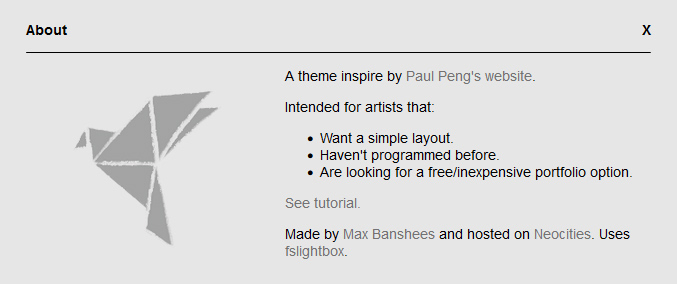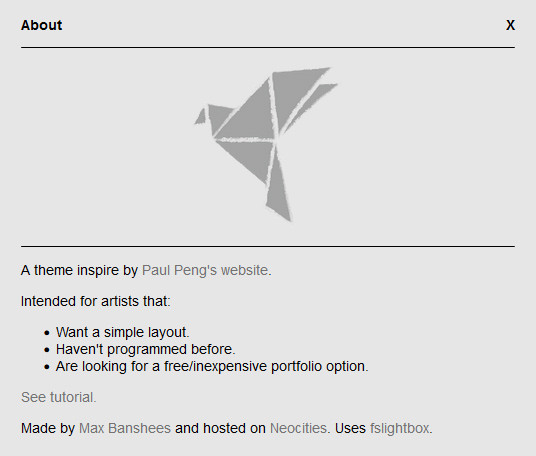Setup:
Go to the Template folder, and open up 'about.html'
Copy all of the code in this file.
Go to the root folder where index.html is, and create a new file.
Name the file what you want to have appear at the end of the URL, ex.: 'about.html' or 'info.html'
Paste the code in the new file.
Differences:
This template uses a new div id called 'page-project', which makes the column on the left narrower than the one on the right. It also keeps caption text aligned to the left across desktop and mobile.
Aside from that, it works the same as the single image page layout.
Suggestions for what to write on your about page:
Some information that clients will look for in the first paragraph:
- Age, written as (b.[year]) after your name
- Profession, ex.: illustrator, comic artist, designer, photographer
- City, region, and/or country you're based in
- A one sentence summary of how your work looks, and/or what motivates you to make it.
Age and location are optional, but it's recommended to have the other two.
After that, you might want to write a paragraph about your projects, clients, or achievements. If you've only recently started to work as a professional, you can list them in chronological order. If you've been working for longer, you can select notable ones.
You can finish your about page by mentioning what universities or programs you've attended, along with your graduation year and any academic honors or club participations. However, this isn't necessary.
You can also briefly talk about your hobbies outside of your profession.
Biographies, artist statements, & CVs:
The information above is categorized as a biography, and is written in third person.
It is different from an artist statement, which is longer, more detailed, and typically written in first person. Here's a guide on how to write one.
An artist statement is optional, but it is recommended for artists who display their works in galleries, or work more within fine art spaces. It is usually included after a biography.
These are also different from a Curriculum Vitae (CV), which is a reverse-chronological order list of your research/work/education experience.
Typically, CVs will have different sections for commissioned work, solo exhibitions, group exhibitions, teaching positions, education, and so on.
Instead of a CV, some people choose to list selected clients after their biographies.
Reference:
I suggest checking out the about & CV pages of other artists for help on how to write yours. Here are a few:
- Paul Peng (Illustrator): About, CV
- Jimmy Simpson (Illustrator & Animator): About & Selected Clients
- Jordan Awan (Illustrator, Professor, Art Director): About & Selected Clients
- Alice Stanne (Book Artist, Professor, Illustrator): About & CV
- Alex Gerasev (Printmaker & Professor): About, Exhibitions

